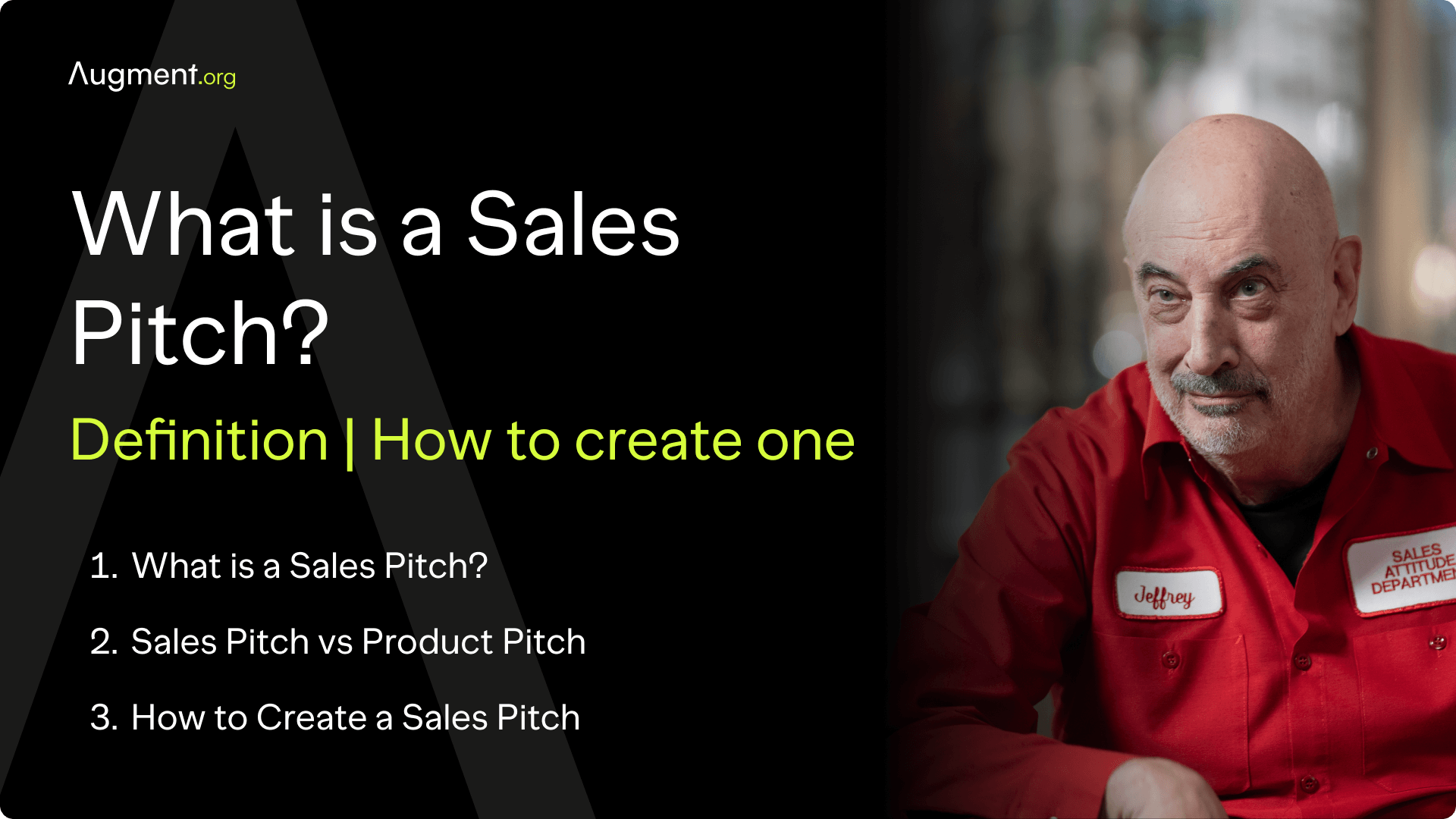What is a Sales Pitch? Definition and How to Create One
A great sales pitch is more than just words; it's the art of convincing prospective clients that your product or service is the solution they need.

What is a Sales Pitch?
A sales pitch is a strategic presentation by a sales rep, aiming to persuade prospective clients about the value of a product or service. It's an essential part of the sales process, carefully designed to capture the prospect's attention and address their specific needs or pain points. The effectiveness of a sales pitch hinges on its ability to convey a compelling value proposition, making clear why the proposed solution is the best choice for the potential customer.
Successful sales pitches are more than just reciting product features; they are about connecting with the target audience on a level that resonates with their interests and requirements. Whether it's a phone sales pitch, an email pitch, or an elevator pitch, the core goal remains the same: to engage the audience and convince them that your offering can effectively solve their problems or enhance their situation.
In essence, a winning sales pitch is the bridge between a sales rep and a successful deal, crafted to turn interest into action.
Sales Pitch vs Product Pitch
Understanding the distinction between a sales pitch and a product pitch is crucial in the art of selling. While they may seem similar, their focus and execution differ significantly.
A sales pitch is all about the value proposition. It's a broader approach where the sales rep aims to connect the product or service to the specific needs or pain points of the potential customer. This type of pitch goes beyond just the features of the product; it delves into how the product can improve the customer's situation, align with their goals, or solve a problem they're facing. The key to a successful sales pitch lies in its ability to be customer-centric, focusing on the benefits and outcomes for the prospective client.
On the other hand, a product pitch is more focused on the product or service itself. It's about showcasing the key features, capabilities, and technical aspects of what's being sold. While this approach can be effective, especially in situations where product differentiation is clear, it may not always establish a strong connection with the buyer's specific needs or objectives.
What are the 'Elements of a Sales Pitch
Effective sales pitches are composed of several key elements that work together to capture the prospect's attention and persuade them towards a positive decision. Understanding these components is vital for any sales rep aiming to deliver the best sales pitch possible.
- Opening Line: The first few seconds of a sales pitch are crucial. A strong opening line should immediately engage the audience, be it a cold call, an email pitch, or a face-to-face meeting. This line sets the tone for the entire pitch and should be intriguing enough to draw the listener's attention.
- Value Proposition: Central to a great sales pitch is a clear value proposition. This is where the sales rep articulates the unique benefits of their product or service and how it addresses the specific pain points of the potential customer. It's about showcasing why your solution is the best fit for their needs.
- Understanding the Target Market: Tailoring the pitch to the specific interests and needs of the target market is essential. A successful sales pitch resonates with the audience because it speaks directly to their desires or challenges.
- Key Benefits and Features: While focusing on the benefits is crucial, a good sales pitch also highlights the key features of the product or service, particularly those that differentiate it in the marketplace.
- Social Proof and Success Stories: Incorporating elements of social proof, such as customer testimonials or success stories, adds credibility to the pitch and helps build trust with potential customers.
- Call to Action: A concise and clear call to action is vital. It guides the prospective client on what to do next, whether it's scheduling a follow-up meeting, signing up for a demo, or making a purchase.
- Closing the Pitch: Concluding the sales pitch effectively is as important as starting it. The closing should reinforce the key points and leave a lasting impression that encourages the prospect to act.
How to Create a Sales Pitch
Creating a sales pitch that effectively resonates with potential customers involves a blend of strategy, understanding, and creativity. Here's a step-by-step guide to crafting a sales pitch that stands out:
1. Understand Your Audience
By deeply understanding your audience, sales reps can create a sales pitch that not only captures the attention of potential customers but also speaks directly to their needs and motivations.
- Research and Analysis: Start by gathering data about your target audience. This can include demographic information, industry trends, and specific challenges they face. Use resources like market reports, social media analytics, and feedback from existing customers. The goal is to form a detailed picture of who your audience is and what matters to them.
- Identify Pain Points: One of the most critical aspects of understanding your audience is knowing their pain points. What problems do they face that your product or service can solve? This could range from a need to improve efficiency, reduce costs, or address specific challenges unique to their industry or personal goals.
- Recognize Buying Motivations: Different customers have different motivations for making a purchase. Some might be driven by the need for quality, while others prioritize cost or convenience. Understanding these motivations is key to tailoring your sales pitch to what resonates most with your potential customers.
- Engage with Your Audience: Interaction with your target market through surveys, social media, or direct conversations can provide invaluable insights. This engagement helps in understanding their preferences, expectations, and opinions about products or services similar to yours.
- Analyze Competitors: Look at how competitors are addressing the needs of your target market. Analyzing their approach can help identify gaps in their strategies and opportunities for your sales pitch to stand out.
- Use Customer Feedback: If your product or service has already been in the market, use customer feedback to understand what's working and what's not. This feedback can guide adjustments in your sales pitch, ensuring it addresses real customer experiences and expectations.
- Adapt to Changes: Keep in mind that the needs and preferences of your audience can change over time. Stay updated with the latest trends and changes in your target market’s behavior. Regular analysis ensures your sales pitch remains relevant and effective.
2. Define Your Value Proposition
A well-defined value proposition is the cornerstone of an effective sales pitch. It clearly communicates why a potential customer should choose your product or service and sets the stage for a successful sales interaction.
- Identify Unique Features: Start by listing the unique features of your product or service. What sets it apart from competitors? This could be anything from advanced technology, superior quality, cost-effectiveness, or even exceptional customer service.
- Translate Features into Benefits: The most crucial step in defining your value proposition is translating these features into tangible benefits for the customer. For instance, if your product is time-saving, explain how this can lead to increased productivity and efficiency for the user.
- Align with Customer Needs: Ensure that the benefits you highlight align directly with the needs and pain points of your target audience. Your value proposition should clearly state how your product or service makes the customer's life easier, better, or more enjoyable.
- Keep it Simple and Clear: Your value proposition should be concise and easy to understand. Avoid complex jargon and focus on clear, straightforward language that communicates the core benefits effectively.
- Make it Memorable: A strong value proposition is not only persuasive but also memorable. It should be catchy enough to stick in the customer's mind, making your product or service the first thing they think of when facing the problem you solve.
- Test and Refine: Share your value proposition with colleagues, mentors, or a small segment of your target audience for feedback. Use their responses to refine and perfect your message.
- Integrate Across Channels: Ensure that your value proposition is consistently communicated across all sales and marketing channels. Whether it's a sales call, an email pitch, or a social media post, the core message should be the same.
3. Develop a Structured Outline
Creating a sales pitch that resonates with your audience requires a clear, structured approach. Here’s how to organize your pitch to ensure it flows logically, captures the audience's attention, and effectively communicates your message:
- Craft a Compelling Opening: Begin your sales pitch with an opening that immediately grabs the audience’s attention. This could be a surprising statistic, a thought-provoking question, or a brief story that relates to the common challenges faced by your target market. The opening should set the tone for the rest of the pitch and make the audience want to hear more.
- Present Your Value Proposition: After the initial hook, introduce your value proposition. This is a concise statement that clearly explains how your product or service solves the customer’s problem or improves their situation. It should be direct and tailored to echo the needs and pain points of your audience.
- Detail Benefits and Features: Next, delve into the specific benefits and features of your offering. Highlight how these aspects address the pain points you mentioned earlier. Remember, benefits should be focused on the outcomes for the customer, not just the technicalities of the product or service.
- Incorporate Social Proof and Success Stories: Bring credibility to your sales pitch by including social proof. Share success stories, testimonials, or case studies that demonstrate how your product or service has effectively helped others. This can significantly increase trust and interest in your offering.
- Use Clear and Concise Language: Throughout your pitch, it’s important to use language that is easy to understand. Avoid industry jargon and complex terms. A concise, clear presentation helps ensure that your message is easily digestible and memorable.
- End with a Strong Call to Action: Conclude your sales pitch with a compelling call to action. This should be a clear, concise directive on what you want the audience to do next, whether it’s scheduling a follow-up meeting, registering for a demo, or making a purchase.
- Keep It Structured and Focused: Ensure that your sales pitch follows a logical flow and stays focused on the main message. Each point should build upon the previous one, leading the audience towards the desired action.
By following this structured approach, sales reps can create a sales pitch that not only captivates the audience but also systematically guides them through the key points, leading to a clear and compelling call to action.
4. Practice and Refine
Perfecting a sales pitch goes beyond just writing it down. It's crucial to practice and refine your pitch continuously. Rehearsing helps in smoothing out the delivery, ensuring that the pitch flows naturally and confidently. Seek feedback from colleagues or mentors and be open to making adjustments. This process not only improves the pitch but also enhances your pitching skills, making you more effective in capturing the buyer's attention and closing deals. Remember, a great sales pitch is a result of diligent practice and refinement.
Tips for Presenting Your Sales Pitch
When it comes time to present your sales pitch, executing it with confidence and clarity is as important as the content itself. Here are some tips to ensure your presentation resonates with your audience:
- Connect with Your Audience: Start by establishing a rapport with your audience. Whether you're in a one-on-one sales call or addressing a sales team, personalize your approach to suit the audience. A personal connection can make your message more impactful.
- Be Confident and Clear: Confidence is key in a sales pitch. Speak clearly and with conviction. Believe in your product or service and let that belief shine through in your presentation.
- Use Visual Aids: If applicable, use visual aids in your sales presentation. This could be a sales deck, graphs, or product demonstrations. Visual elements can help illustrate your points more effectively and keep the audience engaged.
- Keep it Concise: Time is valuable, so keep your sales pitch short and to the point. Focus on the key elements of your pitch and avoid overwhelming your audience with too much information.
- Anticipate Questions: Be prepared to answer questions from prospective clients or the sales team. Anticipating their concerns and having ready responses shows your expertise and thorough understanding of your product or service.
- Show Enthusiasm: Your enthusiasm for your product or service is contagious. Show your audience that you are passionate about what you're offering, which can help in capturing their interest.
- Follow Up: After the sales pitch, don't forget to follow up. Whether it's through a quick call, an email, or social media outreach, following up is crucial in maintaining the connection and moving towards closing the deal.
Sales Pitch Example
Let's imagine a sales pitch for a cutting-edge project management tool, aimed at improving efficiency in small to medium-sized businesses. The sales rep, Alex, has a meeting with a potential client, Jordan, who is the sales manager of a growing tech company.
Opening:
Alex begins with an engaging question, “Did you know that, on average, teams spend 20% of their workweek tracking down project status updates?” This question addresses a common pain point - inefficiency in project management.
Value Proposition:
Alex then presents the value proposition, “Our project management tool, ProjectPro, simplifies tracking and increases team efficiency by up to 30%, allowing you more time to focus on growing your business.”
Benefits and Features:
Alex highlights key benefits: “ProjectPro offers real-time collaboration, automated progress tracking, and customizable project dashboards. It’s designed to streamline your team's workflow and reduce time spent on administrative tasks.”
Social Proof:
To add credibility, Alex shares a success story, “Just last month, TechSolutions, a company similar to yours, implemented ProjectPro and saw a 25% increase in project delivery speed within the first quarter.”
Visual Aid:
Alex uses a concise sales deck to show how ProjectPro works, visually demonstrating the software’s ease of use and its various features.
Anticipating Questions:
Expecting Jordan’s concerns about integration, Alex explains, “ProjectPro easily integrates with your existing tools, ensuring a smooth transition without disrupting your current processes.”
Closing with a Call to Action:
Alex concludes, “I’d love to set up a demo for your team to see ProjectPro in action. How does next Tuesday sound?”
Follow-Up:
After the meeting, Alex sends a follow-up email to Jordan, thanking him for his time and reiterating the key points from their discussion.



